Contemporary Photography
A collection of the best of new Contemporary Photography from the UK and around the world



This page Fenced Flight © Sujata Setia Front Cover Blooming Traditions ©











A collection of the best of new Contemporary Photography from the UK and around the world



This page Fenced Flight © Sujata Setia Front Cover Blooming Traditions ©










Contemporary Group ethos - Photography that conveys ideas, stimulates thought and encourages interpretation; photographs ‘about’ rather than ‘of’.
This publication is produced by the Contemporary Group of the Royal Photographic Society.
The copyright of photographs and text in this issue belongs to the author of the article of which they form part, unless otherwise indicated. No part of this publication may be reproduced in any form without permission of the copyright holder. Any requests can be addressed to the Editor.
Editor Paul Ashley ARPS
Designer Christine Pinnington LRPS
Proof Reader Ann Cameron
95
2025 ISSN 0959 - 6704
If you wish to submit articles for the Journal, please send all copy and images to:
Paul Ashley (Editor), 59 Gilbert Road, Cambridge CB4 3NZ contemporaryeditor@rps.org
Text should be in Microsoft Word. Images are preferred in TIFF format, although high quality JPEGs are also acceptable. Images should be at least 2500 pixels on the longest edge. For other formats or to discuss reproduction, please contact the Editor. Large image files may be supplied on disk or memory stick, or by use of on-line file transfer services, such as WeTransfer or Dropbox. Unless requested, disks and memory sticks will not be returned.
Deadline for the November 2025 issue is 1 October 2025.
Welcome to the May edition of RPS Contemporary Photography. Now that we publish twice a year, perhaps we should label them the Spring and Autumn editions.
We don’t set a theme for each edition, preferring to start with an open mind. But by the same mysterious process as when I go out with a camera for a walk and a concept emerges as I start shooting, so a common thread emerges as photographers come under consideration. This time it was perhaps inevitable, given the wars in Ukraine, the Middle East and Sudan, plus, most recently, the raising of tariffs by the United States against the rest of the world, that ‘conflict’ emerged as the thread early on.
It emerges most shockingly in the photography and words of Abdelrahman Alkahlout, witnessing first hand and very personally the human, cultural and urban destruction of Gaza. If one can lift one’s eyes from images of very specific moments, his work asks questions of all of us about how peoples of different nations, faiths and races can live together. The same thread explicitly runs through Nikita Teryoshin’s detached (‘Nothing Personal’!) and wry documentation of the global arms trade.
The thread of ‘conflict’ is seen in our other contributors, sometimes very visibly, sometimes less so. Chelsea Pineda explores the legacy of her father as a renowned street fighter in the Philippines; fighting – more exactly, wrestling – under strict rules is the ambition of the young boys growing up in Georgia followed by Vincent Duluc-David. Sujata Setia’s large prints, physically lacerated by cuts, reflect the abuse described in painful detail by her survivors. Philippa James shows her daughter and friends tentatively navigating a world in which misogyny and abuse are rarely far away. Daria Nazarova reflects on her relationship with her own body, working as a life model in Georgia after leaving home when Russia invaded Ukraine.
At the other end of both thread and journal from Alkahlout’s images is Elroy Salam’s gentle story of Ataya, the West African tea ceremony. As he describes it, it is “a ritual, a moment of stillness and connection that brought people together”. It would have been good to end the journal with this work – but perhaps it would have been too tidy.
Paul Ashley ARPS, Editor
This project is rooted in childhood memories and the quiet moments spent watching my uncle prepare Ataya. I sat beside him as he carefully brewed the tea, poured it between glasses to create the perfect froth, and shared it with friends and family. It was a ritual, a moment of stillness and connection that brought people together.
Ataya is more than just a drink; it is an essential cultural practice in many West African communities. The preparation is a meditative process - one that requires patience, precision, and care. Traditionally served in three rounds, each with its own symbolic meaning, Ataya represents different phases of conversation, deepening relationships with each sip. The first is strong and bitter, the second is smoother, and the third is sweet. The ritual is a language of kinship, a way to navigate friendship, resolve conflict, and create a sense of belonging.
The series highlights how Ataya serves as both a ritual and a form of personal escape, exploring the tension between the physical and emotional states it evokes. It is in these moments— of waiting for the tea to brew, of watching steam rise, of hands passing glasses—that stories are told, silences are shared, and bonds are strengthened.
One of the central images, Sugar High, presents a figure in a state of inebriation, draped in red shorts, sitting against a white backdrop with fabric concealing their face. The individual clutches a tea kettle in one hand and glasses in the other, embodying both presence and detachment. This image plays with the idea of Ataya as a double-edged experience—it invigorates, yet it lulls; it connects, yet it isolates.
Ataya is a link between the past and the present, between personal history and collective memory. My photographs merge the staged with the documentary, creating a visual language that speaks to both lived experience and artistic interpretation. Some images are composed to evoke an emotional or psychological state, while others capture the spontaneous, everyday interactions that unfold around the tea-making process. Together, they form a tapestry of moments—quiet, intense, reflective, and deeply human.
While Ataya is known for its social aspect, it also holds space for solitude. There are times when the act of brewing is done in silence, where the repetition of pouring and waiting becomes a personal
meditation. In these solitary rituals Ataya takes on another meaning—one of self-reflection, of memory, of searching for clarity.
Brewed Reflections: The Poetry of Ataya is a meditation on how rituals shape us. It is about tradition, but it is also about change - about how cultural practices evolve yet remain anchors in our lives. It invites viewers to consider their own rituals, the moments that bring them closer to others, and the quiet pauses in between. Whether shared in a group or experienced alone, these small, everyday acts hold meaning far beyond their surface.
Through this project, I hope to honor the beauty and depth of Ataya, to share its poetry, and to reflect on the ways in which rituals like this help us navigate our identities, our communities, and the spaces in between.
See: Instagram @elroysalam



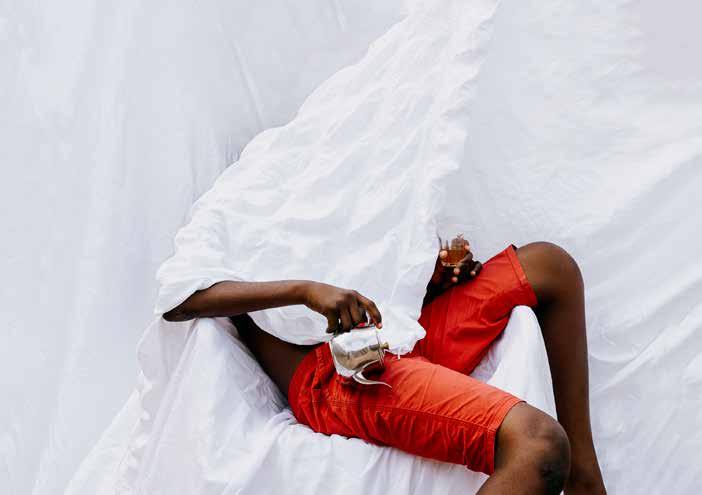
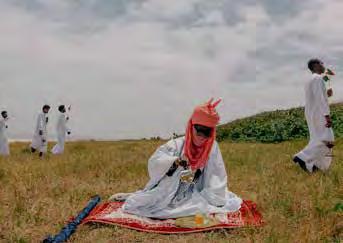


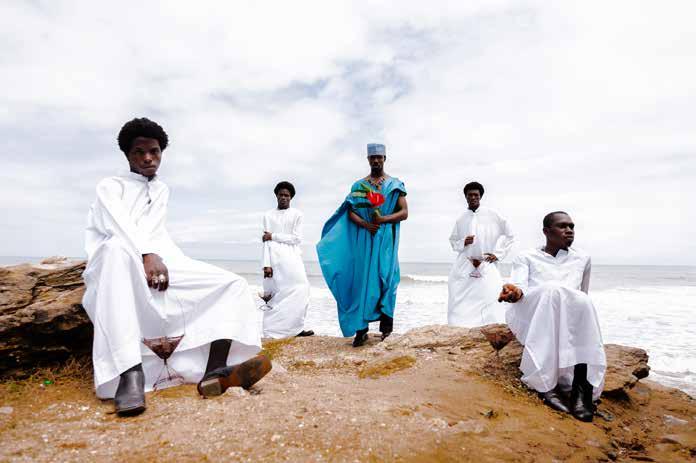
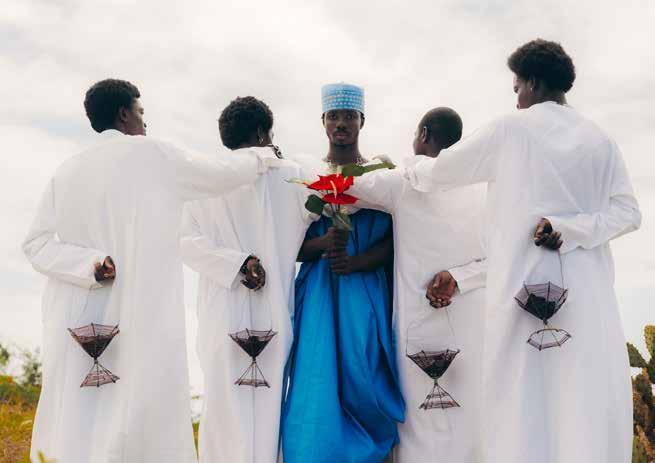
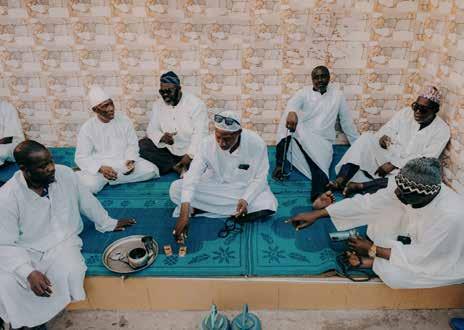


Vincent Duluc-David
The Only Dream is a photo-documentary project set in Georgia, highlighting the ambitions of children aspiring to become professional wrestlers. With a poetic and admiring gaze, Vincent Duluc-David captures the delicate balance between gentleness and violence.
Born of several trips made between 2023 and 2024 to the country, which has a long history with wrestling, the project explores social determinism and the notion of ‘making a man’. Georgia is deeply passionate about this sport, and children are initiated into it at a very early age. Wrestling is a way of building strong character, a school of life that consolidates a model of a robust man. Each child learns to fit in with social expectations, shaping his identity in the shadow of an omnipresent masculine figure. “Not all of them will become champions, but at least we'll make men of them”.
Crystallized in post-Soviet environments that have suffered the ravages of time, the images explore historical, cultural and religious resonances, creating a palpable link between the past and the future in a country searching for independence, and still marked by political tensions. In these degraded environments, every crack, every peeling wall, becomes a silent witness to the efforts and dreams that are forged there. The training is intense and rigorous. Even when injured, the youngsters have to attend classes, watch the others and continue their weight training. Their sculpted bodies already bear the scars of the discipline: scratches, scars and, above all, those famous ‘cauliflower ears’, the result of repeated trauma and considered as a symbol of pride and strength.
These young wrestlers, innocent like children yet serious like adults, show enthusiasm and timidity in their eyes. The portraits, in which the faces are sometimes hidden by effort or, on the contrary, captured head-on, act as a mirror. They take us back to our own childhood memories and our relationship with the transmission of values.
Through this visual quest, Vincent Duluc-David reflects on how the children shape their future through the prism of a sport that defines not only their physical appearance but also their identity and their role in society.
The Only Dream presents a non-exhaustive aesthetic vision of the cultural similarities and differences between these young wrestlers while highlighting their sociological perspectives.
See: vincentdulucdavid.com
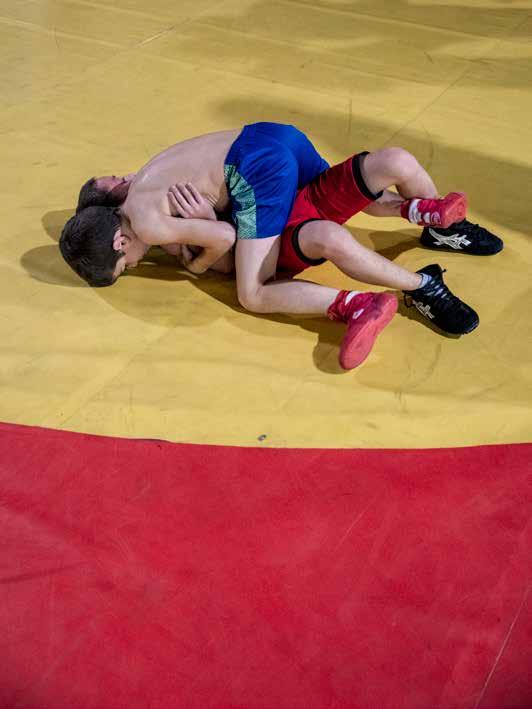

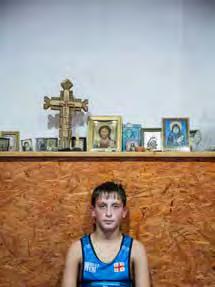




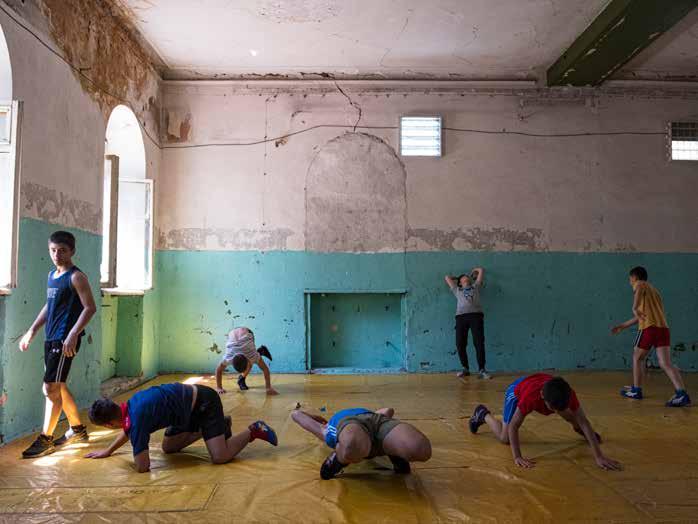

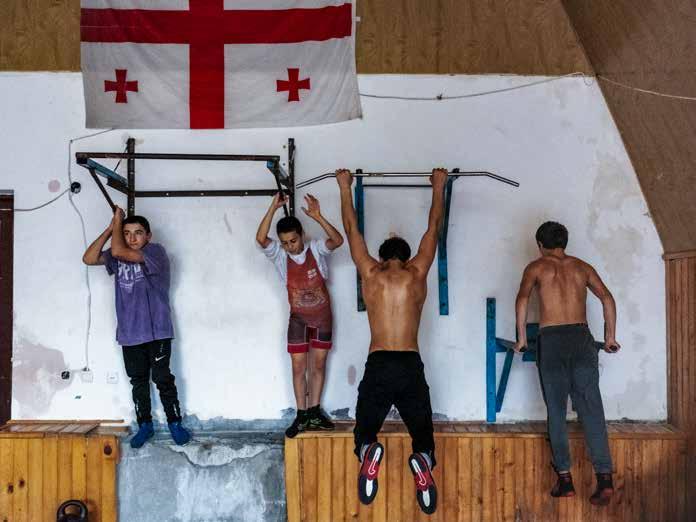



Almost every day on the news we watch pictures of war and destruction; the expenditure on armaments is setting new records year after year. Let‘s take a look at the other side of the subject, behind the curtains of the global defence business. Nothing Personal shows the back office of war, the complete opposite of a battlefield: an oversized playground for adults with wine, finger-food and shiny weapons. Dead bodies here are mannequins or pixels on the screens of simulators. Bazookas and machine guns are plugged into flatscreens and war action is staged in an artificial environment in front of a hall full of high ranked guests, ministers, heads of states, generals and traders.
I deliberately don't show the faces of the businessmen. It is not my intention to fix everything upon a certain person. The anonymized traders with weapons coming out of their heads could be seen as a reference to John Heartfield's anti-war drawing from the 1930s: Dangerous Dining Companions. I like the Idea of this symbolism.
Nowadays companies use slogans like, “70 years defending peace” or, “engineering a better tomorrow”. It is hard to imagine, that some people in the weapons industry believe these things. Still, there is the quote from Richard Gatling, the inventor of the machine gun:
“It occurred to me that if I could invent a machine – a gun – which could, by its rapidity of fire, enable one man to do as much battle duty as 100, that it would, to a large extent, supersede the necessity of large armies and consequently, exposure to battle and disease be greatly diminished.”
His motivation was not to accelerate the process of killing, but to save lives by reducing the number of soldiers needed on the battlefield. The future Gatling wrought was not one of less bloodshed however, but unimaginably more. The Gatling gun laid the foundations for a new class of machine; the automatic weapon.
The pictures have been taken between 2016 and 2020 at 14 defence exhibitions to date, in 13 countries in Europe, Africa, Asia, North and South America (Poland, Belarus, South Korea, Germany, France, South Africa, China, United Arab Emirates, USA, Peru, Russia, Vietnam and India). The final goal of the project is to make pictures on every continent and to underline the global aspect of this very specific business.
Nothing Personal was published as a book by GOST in 2024 (ISBN 978-1-915423-22-1).
See: nikitateryoshin.com
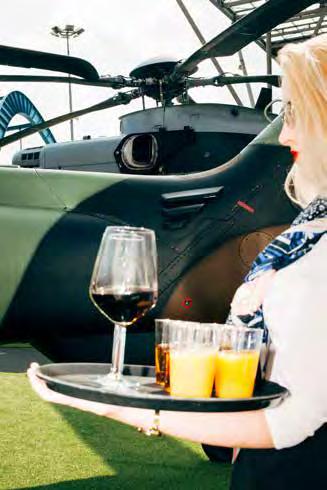



Photography





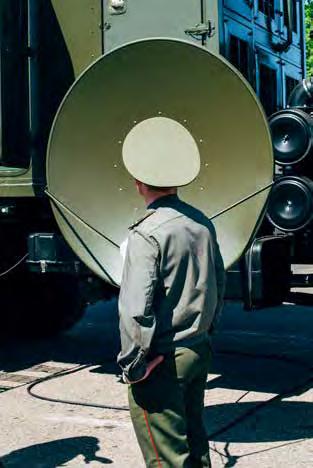
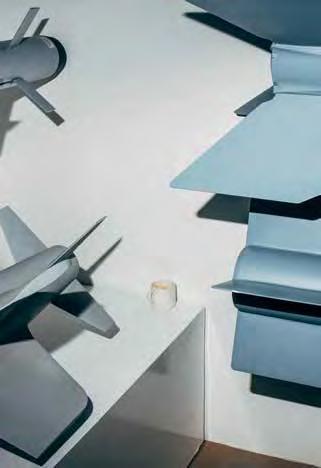

Philippa James
A TikTok soundbite “Once a Slag, Always a Slag” blares out of my daughter’s phone as she shows me a video of herself and a friend performing for the camera.
I watch, caught between discomfort and curiosity. Are they mocking the phrase? Reclaiming it? Or are they unconsciously submitting to its weight? I think about the gendered scripts they’ve inherited and wonder if they are shaping the narrative, or if it’s shaping them.
In the ‘90s, my experience of reclaiming female-derogatory words was tangled with the rise of ‘girl power’, when feminism went mainstream for the first time. But I now wonder if I was truly reclaiming those words, or if was I just trying to be one of the boys – or more precisely, to be accepted by them? It’s complicated, exhausting, relentless - the contradictory messages imposed on girls and women. On one hand, beauty and desirability are celebrated, a source of validation; yet on the other, we are shamed, blamed, and told to cover up. As author Laura Bates describes, it’s as if we are asked to be both Madonna and whore all at once.
I began this project intending to explore the relationship teenagers have with their mobile phones. But my research shifted when I witnessed the intimate female friendship between my daughter and her friends - kisses and cartwheels, childish wonders, social awkwardness, and love hearts – gosh, so many love hearts - scribbled on hands, graffitied onto community walls, even tattooed onto each other’s ankles. Then, my research shifted again as I saw all this unfolding within a world of misogyny, infiltrating both their physical and digital spaces.
In 2021, in response to testimonies published on the Everyone’s Invited website, the government asked Ofsted to commission a rapid review of sexual abuse in schools and colleges. It found that 81% of girls have experienced rumours about their sexual activity, 88% of girls had pictures or videos sent to them that they did not want to see, and 78% of girls had been sexually assaulted. The girls in this project told me this was simply the norm, an expected part of their everyday lives. As author Soma Sara says, it’s seen as no big deal.
As the love heart symbol kept appearing, I reflected on how the desire to be desired is complex and messy. It’s not straightforward, especially for an adolescent. You want attention but not misogynistic language; you want to be noticed but not catcalled: you want a DM but not a dick pic; you want a laugh - but not a rape joke.
Once A Slag offers a glimpse into the complexities of Western girlhood - where nostalgic images of teenagers hanging out, carefree and unguarded, are paired with handwritten accounts of sexual harassment, exposing the inescapable presence of misogyny - both on and offline.
See: philippajames.net


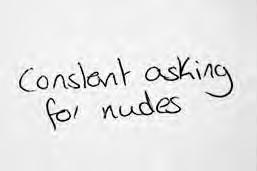
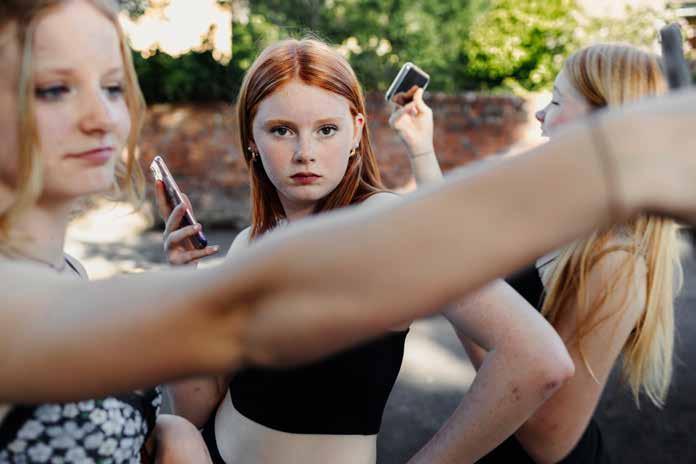

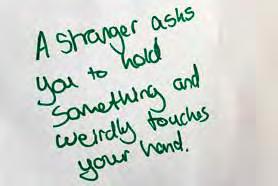
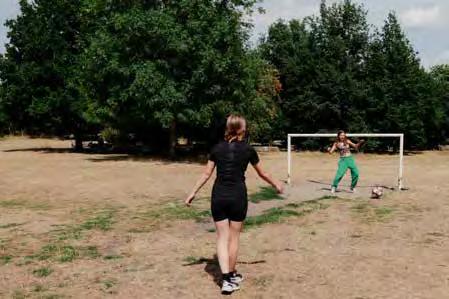




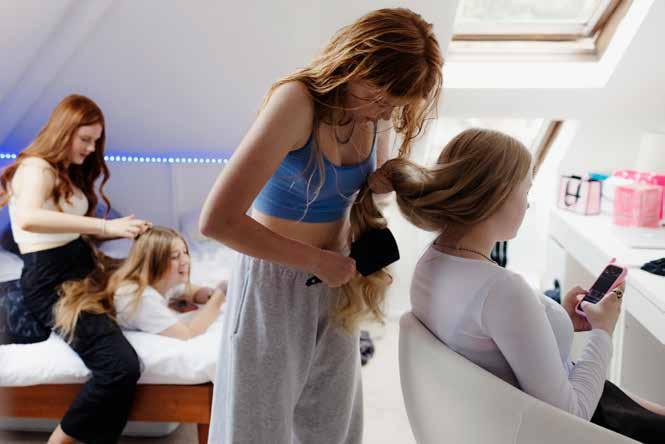

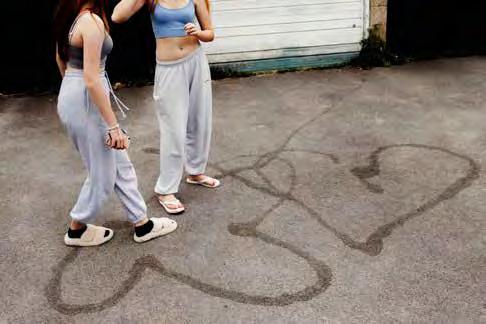

Barako is a deeply personal and evocative photographic project from Filipina-American artist Chelsea Pineda. Through original imagery, archives, and writing, the work re-examines the remnants of her father’s turbulent youth as a serial street fighter in the Philippines. Revisiting the remains and memories of 1960-70s Manila and Lucban through a contemporary lens, the project explores themes of masculinity, familial trauma, and the quiet tenderness that shaped her father’s life.
Barako delves into the life of Pineda's father, Romel, a young man who survived the streets as a serial street fighter trained in martial arts and boxing. While the era glorified the ‘tough guy’ or ‘barako’ archetype, his aggression stemmed not only from the need to protect himself but also as an outlet for the anger he harboured towards his own aggressively disciplinary father. Behind the hardened exterior, however, lies a narrative of compassion: moments of care, such as Romel sneaking food each night to a friend in need or finding solace in nature, punctuate the storyline. The project also reflects on his emotional journey, which culminated in his final fight and the tender embrace of his grandfather after his father’s funeral - his father’s death being the event that marked the end of his fighting days.
Pineda’s Barako is not just a recollection of violence or authority; it’s a meditation on the complexities of masculinity and boyhood. In her work, Pineda recognizes that we know of the aggression and dominance associated with the hegemonic masculinity that many young boys and men are conditioned into. But by navigating the intergenerational effects of this survival-minded masculinity passed down throughout a long family lineage, Pineda invites viewers to ask: what of the tenderness and curiosities that come with the nature of boyhood? What of that is just as necessary in physical and emotional survival, especially when a boy becomes a man? What of that survives?
The importance of Barako lies in its aim not to reproduce or glorify images of violence, but to evoke the visceral emotions that accompany the struggle for identity and survival in a world conditioned by rigid notions of masculinity.
See: chelseapineda.com
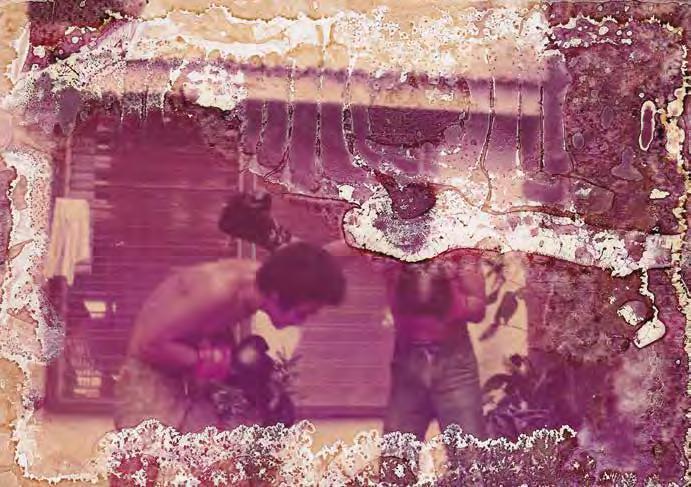

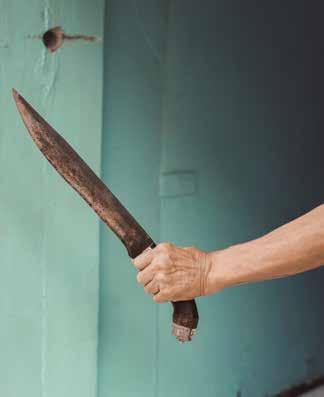
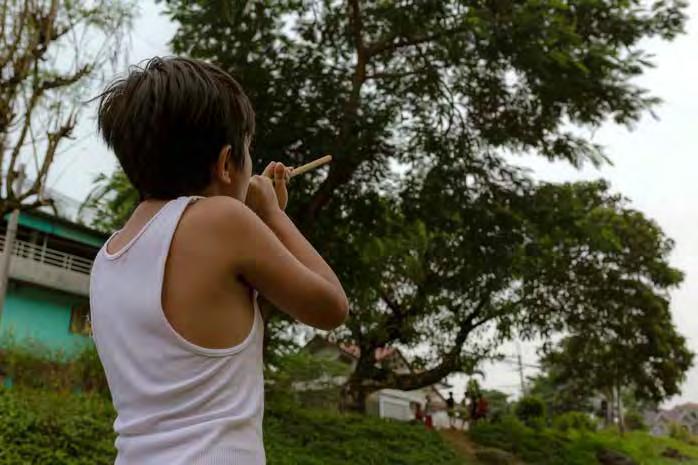
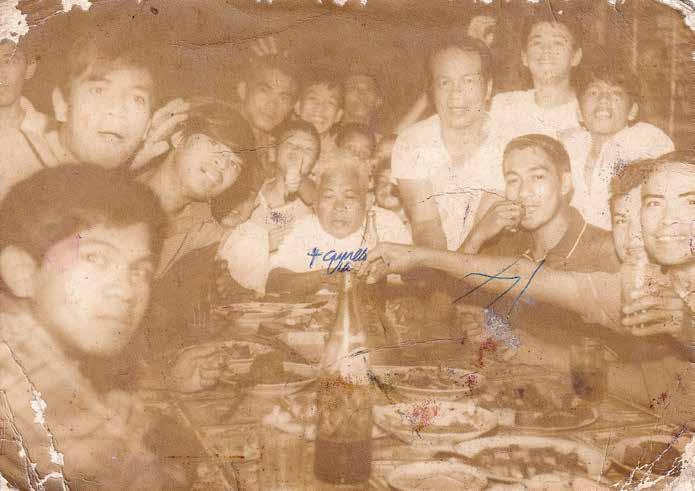



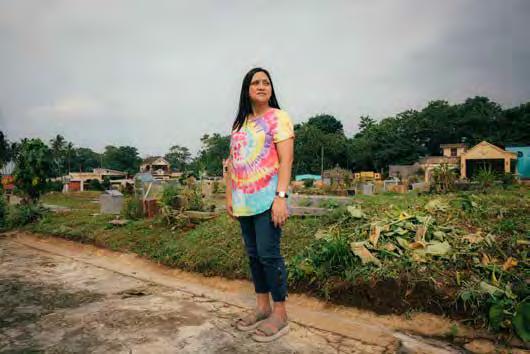

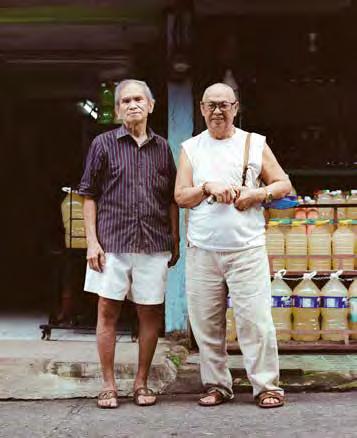
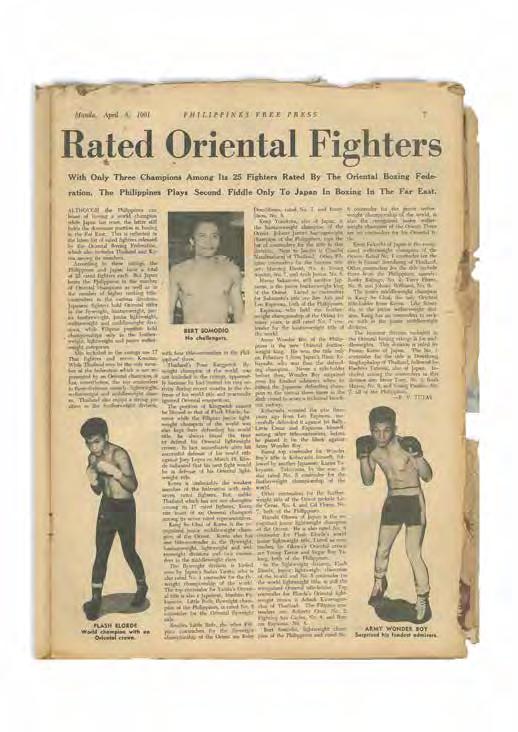

Derived from the ancient Asian form of torture ‘Lingchi’, A Thousand Cuts studies patterns of domestic abuse in the South Asian community.
I have borrowed the metaphorical meaning of Lingchi to showcase the cyclical nature of domestic abuse. The continuous act of chipping at the soul of the abused is expressed by making cuts on the portrait of the participant. The paper used to print the portrait is a thin A4 sheet, depicting the fragility of her existence. The red colour underneath the portraits signifies not just martyrdom and strength but also the onset of a new beginning.
This series studies the journey of abuse from the private, intimate space where violence occurs to its place in the public domain, whether it be in terms of how the private reality is subverted, decorated in public, or that initial disclosure process when the survivor breaks their silence and speaks out to family, friends, neighbours, colleagues or even absolute strangers. This photographic study draws on interviews with 21 South Asian women (it is an ongoing project) and analyses the interactional and emotional processes of the first public disclosure of their private reality.
Through the individual narratives of the survivors we see how coercive control involves regulating the minutiae of everyday life including how women dress and do housework, whom they meet and talk to, and depriving them of or restricting their access to even the most basic necessities of life such as food, water and fresh air.
Once I printed the images, the survivor selected the image she wanted me to start making the cuts on. The motifs made through these cuts are a metaphorical representation of the women’s own lived experiences. Here, I employ the technique of the South Asian art of paper cutting called Sanjhi Art. Historically Sanjhi art works were created by the Hindu god Krishna’s female consorts to attract his attention, showcasing an inherent power imbalance between genders. I wanted to create these contemplations of not just abusive lived experiences but also an inquiry into culture.
By making physical cuts on the survivor's portrait, the endeavour is to showcase the juxtaposition of many energies and realms of individual and systemic consciousnesses, in the act of normalising abuse. The focus is on narratives of the South Asian subject. One finds in there, a certain similitude of hegemonic masculinity and a history of colonisation that then helps us sketch out broad patterns that might provide useful lines of inquiry.
See: sujatasetia.com
I married 2 people in my life. They were very similar to each other. I got divorced from both of them for the same reason. I married my 1st ex because he was a relative of my father and I married the 2nd ex because of honour. I lived with the 1st for 14 years and 8 months. And I lived with the second ex for 1 year but it is like 14 years. My first ex's uncle harassed me. Look how same this life story is. Two husbands. Same kind of husbands. My second husband agreed with my cousin, who is my sister’s husband… to harass me. My cousin started to threat me. He said “your ex-husband sent me your naked pictures. Come sleep with me." I can’t go into details, or I will go into a panic attack. My cousin contacted my brother and my brother and my father came to kill me. He said “You talk to another person who is not your husband or brother or father.” I have a lot of bad experiences in my life. I tried killing myself three times, because they pushed me to kill myself. My brother locked me in a room for three months and they would just come, give me food and go. I lost my memory in those three months. My mother took me out one day, but my brother told me to go find food in the garbage because I dishonoured their family. All of the family was against me. We were 7 daughters and 4 sons. Anyone who came in through the door, my father would give our hand to them in marriage.
Once during our fights related to him keeping control on all my money, he started speaking badly about my mother and my upbringing, so I started recording everything he was saying on my phone. I decided I will send the recording to my family. I went with my phone to my room. He came to the room, snatched my phone and held my neck tightly and said “women like you are worth killing. Let me see who will save you today.” I pushed him and ran towards the door. He ran after me and said “no one will protect you.” I was so lost in that moment. I couldn’t even fathom where the elevator was. I was crying so loudly. Like one cries when someone has died. Just beneath our apartment there was a cash and carry shop. I barged into it. I begged the owner of the
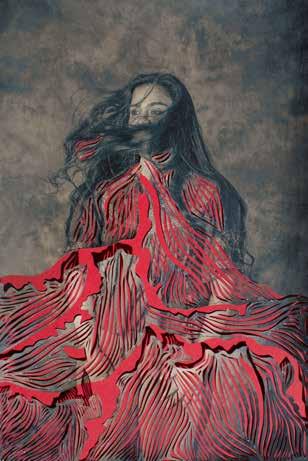
shop to help me call my family back in my country. He hid me in the store and said he will come after attending the customers. I wasn’t able to breathe. That man helped me call my mother. My mother asked me to call the police. That shop owner helped me call the police. Police came. They saw the marks around my neck and arrested him. Meanwhile back home his family went over to my parents’ home. When my father got to know of what I had done… he harassed my mother and hit her. My mother said to me “what is happening to me… let it happen. Don’t take it on your soul. You protect your life. I wasn’t able to help you earlier but I cannot let you die like this. Don’t return to that man for my sake.”
I remember as a kid, we were left outside to play. There was a lot of construction ongoing in our neighbourhood. Everywhere I looked, I saw a mountain of sand and cement. I would pick a pebble from the street and make circles in sand. Was it because I was seeking the shelter of her womb everywhere? Did her womb protect me? Or was it the perception of protection that became my understanding for the rest of my life? My mother’s womb. It’s from there that I started witnessing the violence. I remember the sound the cemented floor made when she was dragged by her hair through it. I was three. I have grown up learning that to be the only sound of music…
One of the recurring dreams I have had is that I am in a zone of war with two children, and I am hiding to protect myself and my children. So I was always foreseeing danger. I would see my house becoming my jail and on the other side of it I could see panthers walking around. My husband was my first cousin. My mother-in-law came from a very abusive marriage herself, and she chose to get divorce and work and become financially independent and support her children. The first seven years of our marriage was good. We were actually in love. But she didn’t like that. She perhaps had an issue with couples being happy. It could be any couple, including her children. So in that sense if I look back at my story, I see her as the perpetrator, but the

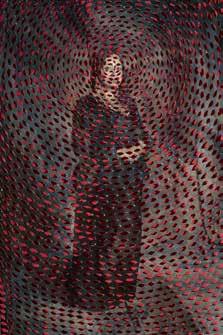
irony is that at one point she was a victim herself. There were days when I would stuff a cloth in my mouth while crying so my children couldn’t hear me because it was so painful. He would threaten me that if I left him, he would make life hell for my entire family. Even if I would go back home at times to my parents, he would call incessantly or show up drunk at the door. So I remember once after a similar incident, I went back home with the kids and saw all the windows were smashed and there were shards of glass everywhere. I remember the trauma my children went through. With all the challenges we’ve had… it’s almost like you get buried and then you rise again. It’s like the phoenix, you rise like the phoenix.
I wouldn't say we were a typical Asian family. My dad kind of isolated us. We weren't even allowed to speak our language. It was only English all the time. And my dad, he worked in like all good jobs like first he worked at the embassy then he worked at the bank. I remember how violent my mum and my parents’ relationship was my dad would get angry at my mum sometimes and he'd hurt her. I think I was very, very little. I remember him, like, silently banging her head on a wall and the blood staying. But on the outside, when you look at our family, we were well dressed, we had nice things, my dad spoke well, we were all like educated well, so on the outside, we all looked really good and our family looked really nice. When I was 16 my mother refused to support me any further. I didn't really have a place of my own. And I was either living with friends or boyfriends. My mom treated my brother very differently to the way she treated me and my sister. Our needs as a girl is not important. If I want to study, that's not important. I mean, if my brother wants to study, yeah, that's important. And so I think that's why when I'm in these abusive relationships with these men, it's their needs first. I always remember my mum working. She'd go food shopping, I'd go and help her. My brother wouldn't help, my dad wouldn't help. So that's the kind of life I was brought up in.


He was divorced and 11 years older than me. I tried to resist. I had just graduated. But because my family was going through a bad time at that time. My father was critically ill. We were struggling financially, and you know that social pressure. So my mum said “look this is a very good option and you won’t get this again. You are getting to go to London.” As a girl in south asian background, you are always raised to be submissive. You cannot have your own say. “A good girl always says yes.” Then he went back to London, and I joined him in 2013. Thing didn’t seem right. He wanted children. He gave me an app to check my ovulation days. After or before that I was nothing to him. He tried so much to get me pregnant. It was like a job for me and it was a horrific job. Then I had my daughter. Not to mention the abuse from my in-laws it was horrific they used to control every single move of my life. I used to cry all the time and my husband was enabling all of it. But now I know, it was not their behaviour but the lack of love and empathy from my husband that made me so unhappy but back then I always thought he loved me a lot because that’s what he would say to me. I decided to live with him for the sake of my kids meanwhile I worked on myself. I learnt driving. I applied for a job. He dissuaded me all the time. He psychologically abused me. He used to tap my phone, my calls. We had cameras everywhere in the house. I felt like I was in a prison.
My parents brought me up with a lot of love. I finished my studies and then I became a school teacher. Someone brought a wedding proposal, and the family liked me. The boy came. When I saw him, I started to cry because he was much older than me. He was 22 years older. But my family told me “It’s ok. You will have a lavish life. If he is older then he will obviously love and respect you.” We got married and I came here to UK. For a year he kept me well and then I gave birth to twins. So once the kids were born my mother in law started to taunt me and a lot of fights started to happen. It was like, they wanted children and that I gave birth to, so my job was done. I remember the words “The machine to produce children has arrived now make as many

as you can.” They kept my and the kids’ passports with them. I was scared. They would not allow me to feed my milk to my own children. They would snatch the kids from my arms. In a few years he filed for divorce. He tried to get full custody of the children because his family knew that if the kids came to me even for a few days then he would have to pay me some allowance. He threatened my kids that if they say that they want to stay with their mother then their father would make sure to never let them see me. So the children said in court that they want to stay with their father. He finally got the custody of the children. Since then, I get to see my children twice a week for a few hours each.
God’s Cow
It was my father and his elder brother’s family that lived together back home in my country. This is the time of my childhood. My cousin, who was the son of my uncle. I was about 5 to 6 years old. He started sexually abusing me. As a child I did not know what was going on, but he would always ask me not to tell anyone. He was about 18-19 years old at that time. Our family then moved to London. And in our community, it was felt that children who grow up in London and go out to malls etc, get spoilt so they should be married off to a man from our home country. So my mother’s younger sister convinced my father to get me married off to a man who was around 16 years older than me. I was 15 and still in secondary school. After the marriage, I came to London, and he stayed back to do his paper work and he was meant to follow me to the UK once his visa came through. However, during that time our family found out that the father of my groom was sexually abusing his own daughters. So my family got me divorced. However, this brought shame to my family. There was this typical scenario where concerns came up about what will society say about having a divorced daughter sitting at home. What will our relatives say! So when my cousin, who had abused me in my childhood came forward to ask for my hand in marriage… I wasn’t ambitious. I was not career oriented. I was a simple, quiet girl who always did what her family asked of her. I was “Allah’s cow.”
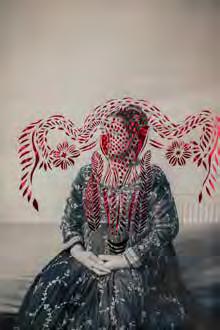

My husband from the very beginning told me that I will not keep you with me. I got married to you only because my parents insisted. From the onset itself he kept forcing me to return to India. I kept hoping he will fix his behaviour, but he didn’t. One day he finally threw me out of the house. For the 8-9 months I lived with my husband, he mentally tortured me to such an unimaginable extent. He would not give me a penny. I wasn’t register at the surgery. I wasn’t even given food. He would come home bring his non-veg food eat it, and he wouldn’t bring anything vegetarian for me. So I would go hungry for days. He never let me get out of the house. Once I fell seriously ill, but he ignored me and did not take me to the doctor. He would torture me so much. I begged him to keep me with him. I begged him to not throw me out of the house. A middle person got us married. I saw him for the first time on the day of our marriage. I was 33 when I got married. One year after my brother got married and brought a wife home. For several years my parents looked for the right man for me, but they never found someone who was good enough. People known to us would ask my father why I had been sitting at home for so many years, but my father would always say that he would not get his daughter married until he found the right man. Maybe it was in my destiny to marry this man which is why my father chose him for me. I was obedient. Wherever my father told me to marry, I got married.
Pinion
I was 21. Everyone was pressurising me to marry and I kept rejecting offers and it bothered everyone. So I just said yes. I was too much into my studies so I couldn’t be bothered. Within a month or two of our marriage he started forcing me to have a kid. It became too much. So I asked him if I could study further because that was my plan. Suddenly it looked like everyone in his family froze. They started complaining about the fee and how they couldn’t afford to pay it. So I decided to do a job but they refused to that as well. “Not possible they said. What will people say that we got an educated daughter in law because we want to make her work?” I started learning to drive. But my husband discouraged and ridiculed me by saying “at least clear the theory. I don't think you are capable of that as well.”

I am not going to lie; he had completely shattered my confidence. I felt like I was capable of doing nothing. I was not allowed to make any friends. If someone came home also and I tried talking to someone, I would be told later not to contact anyone. I was not allowed to go out anywhere. I once wore clothes of my choice so I was immediately asked to change on the pretext that “what will people say to the kind of clothes you are wearing.” It were such little and petty things… the minutiae of everyday life … the control. That I used to say to myself “I am overthinking.” Also, when you have not grown up witnessing such coercion then you don’t even recognise the red flags.
Let me tell you that I was a star before marriage. I earned a degree in finance and in my family no woman had this degree ever and I had a job. I was the youngest daughter, so I was the envy of my brothers and other siblings. When I got married, within 15 days I realised this marriage was really wrong for me. But when I was getting married, my sister told me “if anything wrong happens to you… please don’t tell anyone. Because I am fixing your marriage. So just let me know, don’t tell anyone else.” So I kept quiet and I thought maybe marriages are like that because I have seen men back home are quite strict. So I kept quiet. He started threatening me that if I say anything to anyone I will be deported from the country. And back home I have an aging father… he asked me to think about all of that. He used to give me some money, but he would keep counting. Then I gave birth to my daughter. It was a difficult delivery. No one came to the hospital and when I got home my husband mistreated me. Around 2014, he stopped me from using the phone. I wanted to take pills so I could not get pregnant again, but he stopped me. He would physically and verbally abuse me. He would lock me in the room and slap me and hit me with a towel. He would treat me like… back home you know a goat. Who always gave birth to 8-9 children and eat food and that’s it. My children suffered a lot of emotional abuse too. I’ve been through all forms of abuse - emotional, verbal, physical, sexual. You name it.
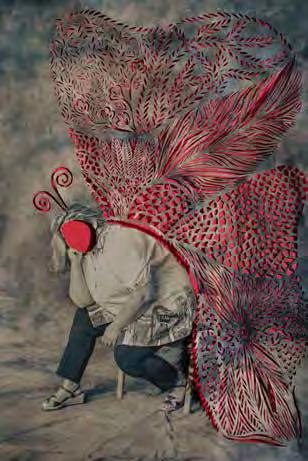
I was young when I had some growth on my chest. People started talking. Some said I had drunk some potion. People turned our life into hell. A marriage offer came from a man in UK who was undergoing treatment for schizophrenia. My mother said “this is your way out.” I took it. I was 16. When I reached London I was taken to the hospital to meet him. When he was not on medication. He was violent. When he was on medication. His family was violent. Amidst my abuse, my children were born. One day I escaped with my children and I went and sat in the middle of the road knowingly that I could be killed here but I said no, I’m not going back to that house because that family will kill me anyway. Traffic was stopped. Police came but did not help. I was sent back. My children grew up watching the abuse. My son is 50 years old now. He’s decided to not have children. He doesn’t want to carry his father’s blood line forward. But you know while I was going through all of this abuse, I started to volunteer for women’s organisations… to empower other women. I had nobody there for me but they have me. So I tell them: Learn English. Get your driving license. Become independent. Don’t rely on anybody. I encourage them. No one encouraged me. I had to do it myself but now I am there for other women.
I have a very good childhood. And my father was very hardworking. He earns for us and he gave us the gift no one can give me like that education. I am a masters from Pakistan. And I was very sheltered. I was not like, I have to go out and work. So it was all my in head that one day I will be like married and I'll find my prince and all that. Yeah, boy was treated as an investment? That they will look after them in their old ages because daughter has to leave one day. So that was all in my thinking and it was all in my mother head because she don't know anything about other than this box and I was also don't know. So the marriage to this man happened after I see him once in the presence of everyone. He was Danish national living in England. But after reaching here he start changing he like keep distancing from me. His mother was verbally abusive. He was also verbally


abusive. I couldn't understand because I'm very new to England. And I thought maybe people are like this. But the planning behind the marriage was to run his brother food business. So it just came to me one night when I just refused to work without payment. So he beat me harshly. And he said, he just brought me here to run his brother's business. So it was a fraud marriage. It took me five months to leave this marriage. because that day my ex -husband went to deliver rice or something to his brother's shop and he forgot in rush to close the door, and I found that the door opened and I ran away.
I didn’t believe until now that it is my story too even though I started to witness the violence from inside her womb. The only vivid childhood memories that I have are of watching her being dragged by her hair around the house in front of my cousins. I remember hiding behind the door and witnessing all of it. Or was I standing in the room? I am not so sure. Where were my brothers at that time? I cannot recollect. I think I was three years old. That year somehow stays with me. That was also the year I remember sleeping in my parents’ bed alone. It was afternoon. I wasn’t in my nappies… no. I think by that time I had just grown out of my nappies. My cousin. I remember him on me… no one else was there in the room. She wasn’t allowed to do anything except for bringing us up the way he wanted us to be brought up. She would cook and clean. He had two sisters, each of whose one son lived with us. They would boss her around as well and enjoy watching her being beaten up. Many nights he would return at early hours of the morning drunk. I remember his head inside the toilet seat. His body hanging like a wet cloth, loosely attached to the scruff of his neck. I am 41 now, I still carry the trauma of my childhood like an invisible limb. My mother has died. Her perpetrators remain alive. Not just the man. Neither all those men or women. Abuse exists within our culture, our genetic predisposition; the gendered narratives that are fed to us.

Statue
I am not able to understand anything. Nothing. I am not even getting any dreams. I don’t feel like doing anything. I don’t feel like doing anything. I am not feeling like doing anything. I am not feeling angry with anyone. I am not able to understand what is happening. I am not able to understand what to do and what not to do. I am neither feeling sad nor happy, I just keep living like this. I am not able to understand anything right now. I am not able to understand anything. I am saying the same thing, I am not able to think of anything. The doctor has given me medicine. I am not able to feel like doing anything. I am not able to understand anything. I am saying this again and again.
In my head I created a calendar, in which every second day… a mishap happened. Life kept going on. But the biggest damage was how possessive he was. What I wore. What I did. Whom I spoke with. Where did I go. He dictated everything. He told me what colour to wear and what not to wear. If I even went to my parents’ home, he would call a 100 times. Everything I did was monitored. If I wore good clothes… he would just tear the clothes. I used to love wearing black colour but because of him black colour permanently got adorned in my life because he wouldn’t let me wear another colour. He would speak lowly of me in front of other people to stifle my confidence. I bore two daughters from this marriage. The abuse continued and this started impacting my children. My youngest daughter became very quiet. Slowly she started losing her hair and she ended up with alopecia. Of course amidst all of this abuse life goes on. We eat food. We go on family holidays. We meet people… life has a way of staying normal amidst all its abnormality.

Unconfined or Unhinged
Photography

Daria Nazarova
“I could still feel that optimism vibrating through the decades: that our bodies are full of power, and furthermore that their power is not despite but because of their manifest vulnerabilities.” Olivia Laing, Everybody.
For a year and a half, I worked as a model in the sculpture workshop of the Tbilisi State Academy of Arts. The stillness of my body became a metaphor for my life, frozen at the moment Russia invaded Ukraine and my husband and I moved to Georgia.
In Georgian, Russian, and several other languages, the word ‘natura’ refers to a model posing for painters and sculptors. In Latin, it means nature. Students observed me, studied me, and sculpted me, perceiving my body as an object of learning. I documented the process and results of our work. By being entirely naked, I showed my openness—a desperate attempt to overcome the alienation of exile and draw closer to others.
My body is my only home. I will hide in it, as if in a shell, among the trees, mountains and caves, among the ancient places of a foreign country. Nature is what is inside me and what surrounds me, it brings peace and consolation. I am a nature frozen in time, a model for creating a sculpture, I am a sculpture myself. I feel connected to all living creatures, but at the same time I feel alone.
I’m trying to integrate into the new world without losing myself, my identity and roots. But who am I? I have character, I must be strong, I must rise up and start moving forward. But for now I look more like a person standing on the station platform while the train rushes past at great speed.
See: nazarovadaria.com












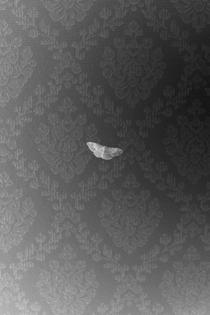



Abdelrahman Alkahlout
I am Abdelrahman Alkahlout, a Palestinian photojournalist from Gaza, where my camera has become my only shield against the Israeli war machine - my weapon in the face of the genocide against my people. Photography started as a hobby, but I quickly realized that documenting the atrocities happening before my eyes was not a choice, but a duty. In Gaza, a journalist doesn’t just hold a camera; he holds a message, a testimony, and perhaps the final words of those whose lives are erased by bombs and missiles.
For over a decade, I have documented Israeli aggression, capturing firsthand accounts of civilians left alone to face death. My work is not just about war; it is about human catastrophe, massacres, and destruction that has touched every home, street, and soul. The Israeli occupation does not differentiate in its targeting - children, women, medical teams, journalists - everyone in Gaza is a target.
I have paid the price for this work multiple times. I was shot six times by the Israeli army, deliberately targeted by snipers despite wearing a clearly marked press vest. I was shot in my leg, both legs, my back, and my shoulder, but the bullet they didn’t fire was the bullet of silence, the bullet of fear, the one they wanted to make me stop reporting the truth - and I refused to break. Even after leaving Gaza for treatment, my images remain a witness to the crime, and I continue to share them with the world, even as I am now forbidden from returning to my besieged homeland.
Despite all the challenges, my photos did not go unnoticed. My work has been recognized internationally, not just as an acknowledgment of my photography but as a testament to the fact that what is happening in Gaza is not just a ‘conflict’ - it is a genocide against an entire people. But these awards mean nothing compared to a mother’s scream over her murdered children, a father digging through the rubble to find his family, or a child opening his eyes to a world that knows nothing but war and siege. This is the Gaza I document - the Gaza that the occupation tries to erase - the Gaza that refuses to die.
Today, I share these images not only because they document the truth but because they are living proof of an ongoing crime before the eyes of the world. The occupation may kill people, demolish homes, and erase entire neighborhoods, but it can never kill the truth, nor silence the lens that carries the voices of the oppressed. I remain on this path, and my camera remains a witness - until the day justice is served and my homeland is free, as it deserves to be.
See: Instagram @abd.pix96




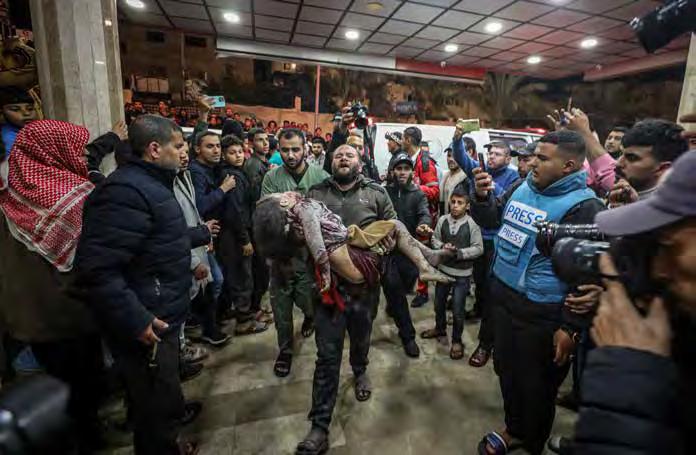


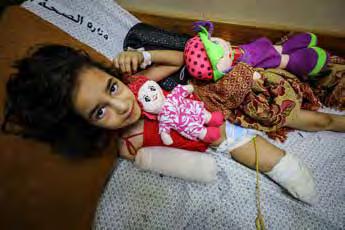
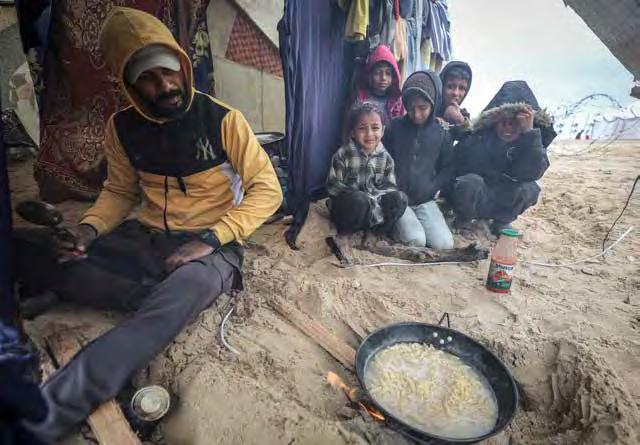
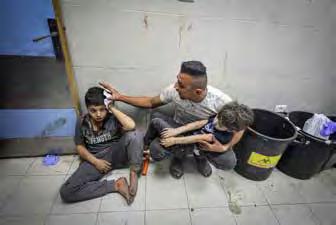
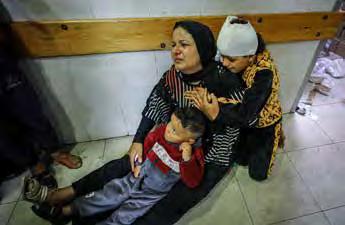

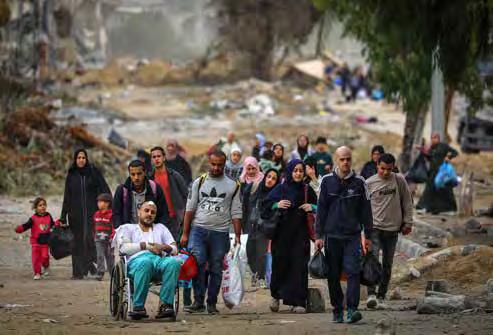

We are all aware of the power of photography. It can draw on the emotions or capture the imagination; it can act as a reality check or stand as a memorial to a historical fact. There are extraordinary single images, perhaps showing the horrors of a particular situation - think of Don McCullin or Nick Ut from Vietnam. And there are collections by a single artist collated for a particular purpose in a photobook or gallery; their strength lies in the overall collection and, more importantly, in the purpose of the collection. One such contemporary photographer is Marc Wilson, author now of six photobooks, with the most recent one just published: Travelogue 2, A Thousand Days Of Longing.
Recently Marc has moved away from longitudinal projects such as Remnants, that explored the First World War forts in the Trentino-Alto mountains, or the epic A Wounded Landscape, that bore witness to the Holocaust and the stories of some of the survivors. Now, rather than seeking out the historical artefacts of war, Marc has found himself personally impacted by a contemporary conflict, the illegal Russian invasion of the Ukraine. The horrors of the drone attacks and missile strikes appear on our TV screens almost nightly, and there is the danger that we become desensitized to the plight of others. Marc, however, has found a way around this in both his previous book The Land is Yellow the Sky is Blue, and this new work. In them he shows us a more peaceful time in Ukraine. As he says:
“for more than 1000 days, since the full-scale Russian invasion of Ukraine began on February 24th, 2022, I have been sharing work from a more peaceful time, from before the full-scale war, as a small daily reminder and a longing for that life.”
The images in this book were taken between 2018 and 2022, with the last taken four weeks after the invasion. It is an extremely personal journey; Marc is married to a Ukrainian, and has family connections to Eastern Europe. The longing and desperation for peace resounds throughout this slim volume. His photographic eye catches both wide vistas and the intricate details of Ukrainian life. His style is very contemporary, filmic and timeless, revelling in mist and dull days, illustrating the peaceful nature of the land and a life that has now been torn asunder by Putin’s actions.
See: marcwilson.co.uk



Simon Ciappara FRPS
Impressions of a cold war nuclear bomb storage facility.… A strange feeling as I wandered around kind of numb.… 60 years ago I was so frightened that there was no point in growing up..…
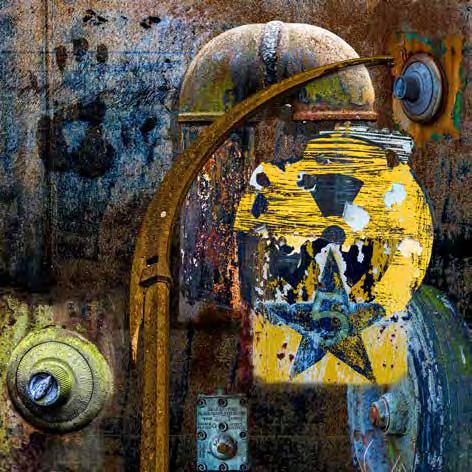
Simon Ciappara is holding an exhibition of abstract images, photobooks and photosculptures at the Halesworth Gallery, Suffolk from the 7 June to 2 July (halesworthgallery.co.uk)
Contemporary Group Committee
Chair Tom Owens contemporary@rps.org
Secretary Tim Hancock ARPS contemporarysecretary@rps.org
Treasurer Alan Cameron ARPS contemporarytreasurer@rps.org
Webmaster Sean Goodhart ARPS contemporaryweb@rps.org
Events Secretary Mike Kitson LRPS contemporaryevents@rps.org
Social Media Burak Oguz contemporarymedia@rps.org
Journal editor Paul Ashley ARPS contemporaryeditor@rps.org
Concept editor Nick Linnett concepteditor@rps.org
Publications Christine Pinnington LRPS contemporarypub@rps.org
North group organiser Patricia Ruddle ARPS contemporaryne@btinternet.com
Eastern group organiser Tom Owens ARPS contemporaryea@rps.org
Central group organiser Steff Hutchinson ARPS contemporarycentral@rps.org
North West group organiser Alan Cameron contemporarynw@rps.org
South West group organiser Adrian Hough ARPS contemporarysw@rps.org
Scotland group organiser Steven Whittaker ARPS contemporarysco@rps.org
Postal portfolio Nigel Corby contemporarypostal@rps.org
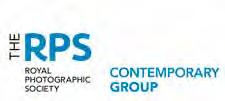
The Contemporary Group continues to hold meetings online and, where possible in person. Keep an eye on the RPS website, Concept and the group Facebook page for forthcoming events.
Contemporary East. Meetings are held online on the first Thursday of each month in the afternoons.
Contemporary North. Meetings are held monthly live at Clements Hall, York, and online, on Saturdays. Contact Patricia Ruddle for more information or see the RPS website.
Contemporary South West. Meetings are held regularly, online and in person. Contact Adrian Hough for details.
Contemporary Northwest. Meetings are held both in person and online. Contact Alan Cameron for details.
Contemporary Central. Meetings are held jointly with the Documentary Group on the second Wednesday of the month at 7pm, online. Contact Steff Hutchinson for more information.
RPS Contemporary Group rps.org/groups/contemporary
Contemporary Group Events rps.org/events-listing/
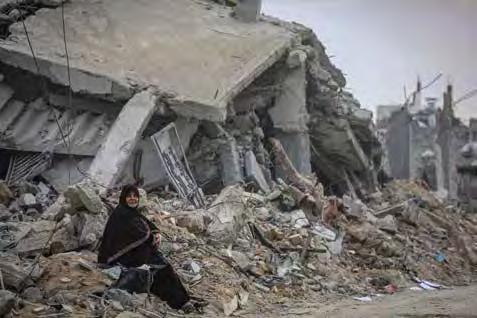
ISSN 0959 - 6704
The Royal Photographic Society rps.org
The RPS Contemporary Group rps.org/groups/contemporary
Past Issues of the Journal online rps.org/groups/contemporary/journal-archive
Scan for more information about The RPS Contemporary Group